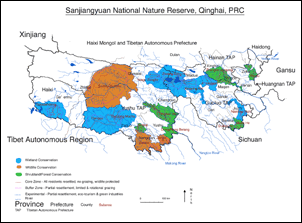green jobs for Tibetans
In June 2008, a short article from Reuters outlined a Chinese master plan for 'ecological security' — to counter the effects of melting glaciers and disappearing grasslands in Tibet. Since 2008, precious little has been heard about this environmental plan, which proposes turning grasslands into protected forests, restricting grazing, and creating "green" jobs for Tibetans that ease pressure from population growth and development. This is what might be termed 'environmental plans with Chinese characteristics'.
A few salient points:
- specific examples of green jobs for Tibetans are not elaborated upon. But Chinese officials have taken away several million green jobs from Tibetans by removing nomads from the grasslands of Tibet. If you want to save the grasslands and keep Tibet green, leave the nomads where they are. They are the real stewards of the grasslands.
- you cannot turn grasslands into forests because most areas are above the tree-line in Tibet. And those that are below the tree-line in eastern Tibet have been so heavily deforested by Chinese loggers that erosion and mud-slides present significant problems.
- if you want to ease pressure from population growth, that's simple: stop waves of Chinese miners and immigrants flooding into Tibet on the railway.
- the plan calls for building of dams to 'provide enough power.' Power for what exactly? Why is dam-building mentioned in connection with environmental plans?
Here's an excerpt from the Reuters story:
LHASA, June 22, 2008: Tibet is planning an "ecological security" plan to counter threats from global warming and rapid development to glaciers and grasslands on the roof of the world, its top environmental official said. Zhang Yongze, director general of the region's environmental protection bureau, said the scale of environmental problems facing Tibet called for a concerted response, and he singled out climate changed as a key worry. To counter these problems, and pressures from population growth, overgrazing and pollution, Tibet has drafted an "ecological security" plan that will soon be submitted to the central government and could be announced by the end of the year, Zhang said.
The plan, which could initially cost 10 billion yuan (US$1.5 billion), would involving turning grasslands into protected forests, restricting grazing and creating "green" jobs for Tibetans that ease pressure from population growth and development. "The solution to problems like global warming is out of our hands, but this document will give us a framework to work in," Zhang said. Tibet would also have to develop more hydroelectric power stations on the region's many rivers—an option opposed by some conservationists—to provide enough power, he said.Protecting the grasslands
National parks? Or sites pegged out for mining and dam construction? Greenwashing knows no bounds in the PRC...
The ultimate 'greenwashing' by the CCP (Chinese Communist Party) is its designation of certain regions as 'national protection areas'. Nomads are bluntly told they must leave such a designated area because it is a national park and thus must remain uninhabited to protect it. There appears to be a much more sinister agenda behind the creation of these protected areas. In a number of cases, after the nomads have been forcibly moved out, mining companies and hydropower engineering consortiums have moved in.
A case in point here is Sanjiangyuan National Nature Reserve in Amdo (Qinghai). Sanjiangyuan means 'Three Headwaters' in Chinese, and refers to the very important headwaters region of the Mekong, Yangtse and Yellow rivers in Amdo. Some context here: looming in the background is a lunatic plan to divert the headwaters of the Yangtse river uphill to the Yellow river through a series of tunnels. This plan embraces three mega-dams—with wall heights of 175 metres, 302 metres and 296 metres—linked to a series of tunnels totalling hundreds of kilometres in length.
This harebrained plan could well cause extensive environmental destruction. Given this context, it is somewhat suspicious that CCP authorities would announce a massive eco-conservation project called the Sanjiangyuan National Nature Reserve in 2000. A larger effort got under way in 2005: this nature reserve covers some 153,000 square km, which is about the size of England and Wales combined. Usually, the first thing done when announcing a national park of this huge size is to issue a map showing its boundaries. Not Sanjiangyuan. A map gazetting the region did not appear in any official source until early 2009. That's because the whole exercise appears designed to bamboozle not only Tibetan nomads, but also watchful foreign outsiders. The official map of Sanjiangyuan that finally surfaced is a chaotic jumble of zones, with 'buffer zones' permitting 'development'. What this refers to is options for mining and for building of hydropower stations. When Canadian mining company Inter-Citic was permitted to start up operations in one such buffer zone, the company alluded to the region as being 'uninhabited'. What they failed to mention is that all the nomads of this region were forcibly shifted off the same grasslands to make way for mining exploitation. This is being done under the cloak of conservation.
One official Chinese website shows a bevy of small dams under use within the region of Sanjiangyuan: one picture bears this curious tagline: 'Benefiting from the ecological protection, this year Sanjiangyuan area in Yushu Tibetan Autonomous Prefecture of Qinghai Province provides enough water to indicate that hydropower stations are in good process.'
It's anybody's guess what that phrasing actually means, but it certainly doesn't sound like conservation.
Map of Three Headwaters (Sanjiangyuan) National Nature Reserve:
ousting the bushmen
The naming of regions as nature reserves is all too often used as a ploy to oust the traditional inhabitants. This happens around the world. In Botswana, when the Central Kalahari Game Reserve was established in 1961, it was concluded that the park could sustain both wildlife and the native Bushmen, as long as the Bushmen hunted using traditional methods. The Bushmen are part of Africa's oldest race of people: their survival depends on their unique hunter-gatherer skills. In 1985, the Botswana government did an about-face, and decided that the Bushmen should be relocated to villages outside the reserve, supposedly because of concerns about over-hunting and disease. A number of Bushmen relocated willingly: those that remained fought vigorously against relocation, but most were forced to leave the bush when the government cut off all services. Survival International equated the Bushman relocation to genocide, claiming that the government strategy was prompted by a keen interest in diamonds. The Central Kalahari Game Reserve lies between two of the largest diamond mines in the world.

